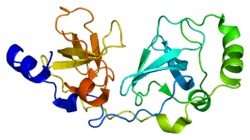SCMH1
Polycomb protein SCMH1 is a protein that in humans is encoded by the SCMH1 gene.[5][6]
References
- GRCh38: Ensembl release 89: ENSG00000010803 - Ensembl, May 2017
- GRCm38: Ensembl release 89: ENSMUSG00000000085 - Ensembl, May 2017
- "Human PubMed Reference:". National Center for Biotechnology Information, U.S. National Library of Medicine.
- "Mouse PubMed Reference:". National Center for Biotechnology Information, U.S. National Library of Medicine.
- Berger J, Kurahashi H, Takihara Y, Shimada K, Brock HW, Randazzo F (September 1999). "The human homolog of Sex comb on midleg (SCMH1) maps to chromosome 1p34". Gene. 237 (1): 185–91. doi:10.1016/S0378-1119(99)00285-1. PMID 10524249.
- "Entrez Gene: SCMH1 sex comb on midleg homolog 1 (Drosophila)".
Further reading
- Tomotsune D, Takihara Y, Berger J, Duhl D, Joo S, Kyba M, Shirai M, Ohta H, Matsuda Y, Honda BM, Simon J, Shimada K, Brock HW, Randazzo F (December 1999). "A novel member of murine Polycomb-group proteins, Sex comb on midleg homolog protein, is highly conserved, and interacts with RAE28/mph1 in vitro". Differentiation; Research in Biological Diversity. 65 (4): 229–39. doi:10.1046/j.1432-0436.1999.6540229.x. PMID 10653359.
- Levine SS, Weiss A, Erdjument-Bromage H, Shao Z, Tempst P, Kingston RE (September 2002). "The core of the polycomb repressive complex is compositionally and functionally conserved in flies and humans". Molecular and Cellular Biology. 22 (17): 6070–8. doi:10.1128/MCB.22.17.6070-6078.2002. PMC 134016. PMID 12167701.
- Luo L, Yang X, Takihara Y, Knoetgen H, Kessel M (February 2004). "The cell-cycle regulator geminin inhibits Hox function through direct and polycomb-mediated interactions". Nature. 427 (6976): 749–53. doi:10.1038/nature02305. hdl:11858/00-001M-0000-0012-EE32-1. PMID 14973489.
- Stelzl U, Worm U, Lalowski M, Haenig C, Brembeck FH, Goehler H, Stroedicke M, Zenkner M, Schoenherr A, Koeppen S, Timm J, Mintzlaff S, Abraham C, Bock N, Kietzmann S, Goedde A, Toksöz E, Droege A, Krobitsch S, Korn B, Birchmeier W, Lehrach H, Wanker EE (September 2005). "A human protein-protein interaction network: a resource for annotating the proteome". Cell. 122 (6): 957–68. doi:10.1016/j.cell.2005.08.029. hdl:11858/00-001M-0000-0010-8592-0. PMID 16169070.
- Lim J, Hao T, Shaw C, Patel AJ, Szabó G, Rual JF, Fisk CJ, Li N, Smolyar A, Hill DE, Barabási AL, Vidal M, Zoghbi HY (May 2006). "A protein-protein interaction network for human inherited ataxias and disorders of Purkinje cell degeneration". Cell. 125 (4): 801–14. doi:10.1016/j.cell.2006.03.032. PMID 16713569.
- Olsen JV, Blagoev B, Gnad F, Macek B, Kumar C, Mortensen P, Mann M (November 2006). "Global, in vivo, and site-specific phosphorylation dynamics in signaling networks". Cell. 127 (3): 635–48. doi:10.1016/j.cell.2006.09.026. PMID 17081983.
This article is issued from Wikipedia. The text is licensed under Creative Commons - Attribution - Sharealike. Additional terms may apply for the media files.






